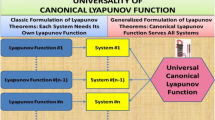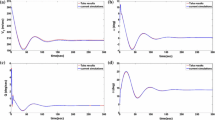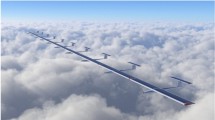Abstract
The conflict between the accuracy and the complexity of the adequate mathematical modelling approximations of physical phenomena is discussed. The need of finding certain types of topological equivalency between nonlinear mathematical models as the keystone to successful study is emphasized. We formulate the control problem when the controlling functions cannot directly act on the phase variables defining a given terminal manifold as a control aim through the right-hand sides of differential equations describing a mathematical model under study. The idea of creating a hierarchical cascade of controlling attractors–mediators is introduced. It is shown how the method of the goal-oriented formation of the local topological structure of one-codimensional foliations as the basis of Poincaré’s-strategy-based backstepping method can be successfully used for designing terminal control. One brings up the problem of developing the tools intended for the creation of the topologically equivalent and quantitative–deviation–tolerable simplifications of the complex original mathematical models suitable for the synthesis of the control laws that are supposed to be applied to the latter ones. The two-dimensional example is analytically investigated to explain the procedure of constructing the cascade of controlling one-codimensional attractor mediators. The essentially nonlinear five-dimensional mathematical model of the longitudinal flight dynamics of a thrust-vectored aircraft in a wing-body coordinate system with two controls, namely, the angular deflections of a movable horizontal stabilizer and a turbojet engine nozzle, is investigated. The core of the designed wide-sense robust and stable in the large-tracking control algorithm is a hierarchical cascade of controlling attractor–mediators consisting of the two one-codimensional manifolds. The results of the computer simulation are presented. The topicality in creating the general theory of nonlinear mathematical modelling, as the tools to construct and manipulate the sets of topologically equivalent models being qualitative–quantitative adequate to corresponding physical phenomena, is pointed up in conclusion.










Similar content being viewed by others
References
Berry, M.: Paul Dirac: the purest soul in physics. Phys. World 11(2), 36 (1998)
Hartman, P.: Ordinary differential equations. Wiley, New York (1964)
Arrowsmith, D.K., Place, C.M.: Ordinary differential equations. Chapman and Hall, London (1982)
Verhulst, Ferdinand: Nonlinear differential equations and dynamical systems. Springer-Verlag, Berlin (1996)
Sparavalo MK (1998) Algorithme du pilotage automatique en pente assurant la stabilité au sens large et la robustesse: Topologie cascadée de la dynamique non-linéaire. Thèse de Mastère spécialisé en Maintenance Aéronautique et Production, ÉNSICA, Toulouse
Aymes, J.M.: Commande adaptive prédictive appliquée au pilotage automatique d’avion. Thèses de doctorat, ÉNSICA, Toulouse (1997)
Lambert, E.P.: Process control applications of long-range prediction. PhD thesis, University of Oxford, Oxford (1987)
Sparavalo, M.K.: The geometry of vector field spaces that have no critical elements: a differential-topological approach to the analysis problem in control theory. J. Autom. Inf. Sci. 27(5&6), 17–28 (1995)
Sparavalo, M.K.: Wide-sense robust and stable in the large terminal control for van der Pol dynamics: poincaré’s-approach-based backstepping method. Procedia Eng. 199, 850–856 (2017)
Nicolis, G., Prigogine, I.: Self-organization in non-equilibrium systems. Wiley, Hoboken (1977)
Haken, H.: Information and self-organization. Springer Verlag, Stuttgart (1988)
Sparavalo, M.K.: A method of goal-oriented formation of the local topological structure of co-dimension one foliations for dynamic systems with control. J. Autom Inf. Sci. 25(5), 65–71 (1992)
Brӧcker, Th, Lander, L.: Differential germs and catastrophes. Cambridge University Press, Cambridge (1975)
Gilmore, Robert: Catastrophe theory for scientists and engineers. Wiley, New York (1981)
Sparavalo, M. K., Canonical generalization of Lyapunov’s second method and general procedure of utilization of Lyapunov functions. In: 13th World Congress on Computational Mechanics and 2nd Pan American Congress on Applied Mechanics, July 22–27, 2018, NYC, US. ResearchGate Database [online database], https://www.researchgate.net/publication/_Canonical_Generalization_of_Lyapunov’s_Second_Method_and_General_Procedure_of_Utilization_of_Lyapunov_Functions [retrieved 03 December 2018]
Author information
Authors and Affiliations
Corresponding author
Ethics declarations
Conflict of interest
The author declares that he has no conflict of interest.
Additional information
Publisher's Note
Springer Nature remains neutral with regard to jurisdictional claims in published maps and institutional affiliations.
Rights and permissions
About this article
Cite this article
Sparavalo, M.K. Adequate mathematical modelling by wide-sense robust control design in a thrust-vectored flight dynamics problem. CEAS Aeronaut J 11, 289–301 (2020). https://doi.org/10.1007/s13272-019-00425-x
Received:
Revised:
Accepted:
Published:
Issue Date:
DOI: https://doi.org/10.1007/s13272-019-00425-x




